Share content related to independent development and product monetization, published every Friday.
Table of contents
1、LLM Scraper: 使用大型语言模型(LLMs)将任何网页转换成结构化数据2、AsPoem: 开源中国诗词学习网站3、增长策略: 如何从LinkedIn上获取60%的客户?4、三周内打造的产品赚了6万美元
1. LLM Scraper: Use large language models (LLMs) to convert any web page into structured data
LLM Scraper is an open source project library based on TypeScript that uses LLMs to convert web content into structured data.
In order to simplify and automate the process of extracting information from web pages, this project uses language models to parse and understand web content and convert it into a more manageable format.
- Function:
- Supports multiple language models: including locally deployed models (GGUF), models provided by OpenAI, and Groq’s chat model.
- Defining schemas via Zod: Zod is a TypeScript library for creating types and validating data structures, which helps ensure data correctness and consistency.
- Fully type-safe: The project is developed using TypeScript, which means it provides compile-time type checking, helping to reduce runtime errors.
- Based on the Playwright framework: Playwright is an open source Node library used to automate the operation of browsers such as Chrome, Firefox and WebKit, and is suitable for testing and crawler tasks.
- Support for streaming: Support for streaming data when crawling multiple pages, which may help improve performance and the ability to handle large amounts of data.
- Input mode:
html: Load original HTML content.markdown: Load content in Markdown format.text: Load the extracted text content and use Readability.js to extract the text. This is a library used to improve the web page reading experience and can extract the main content from the web page.image: Loading screenshot, suitable for multimodal input (i.e. models that handle both text and images).
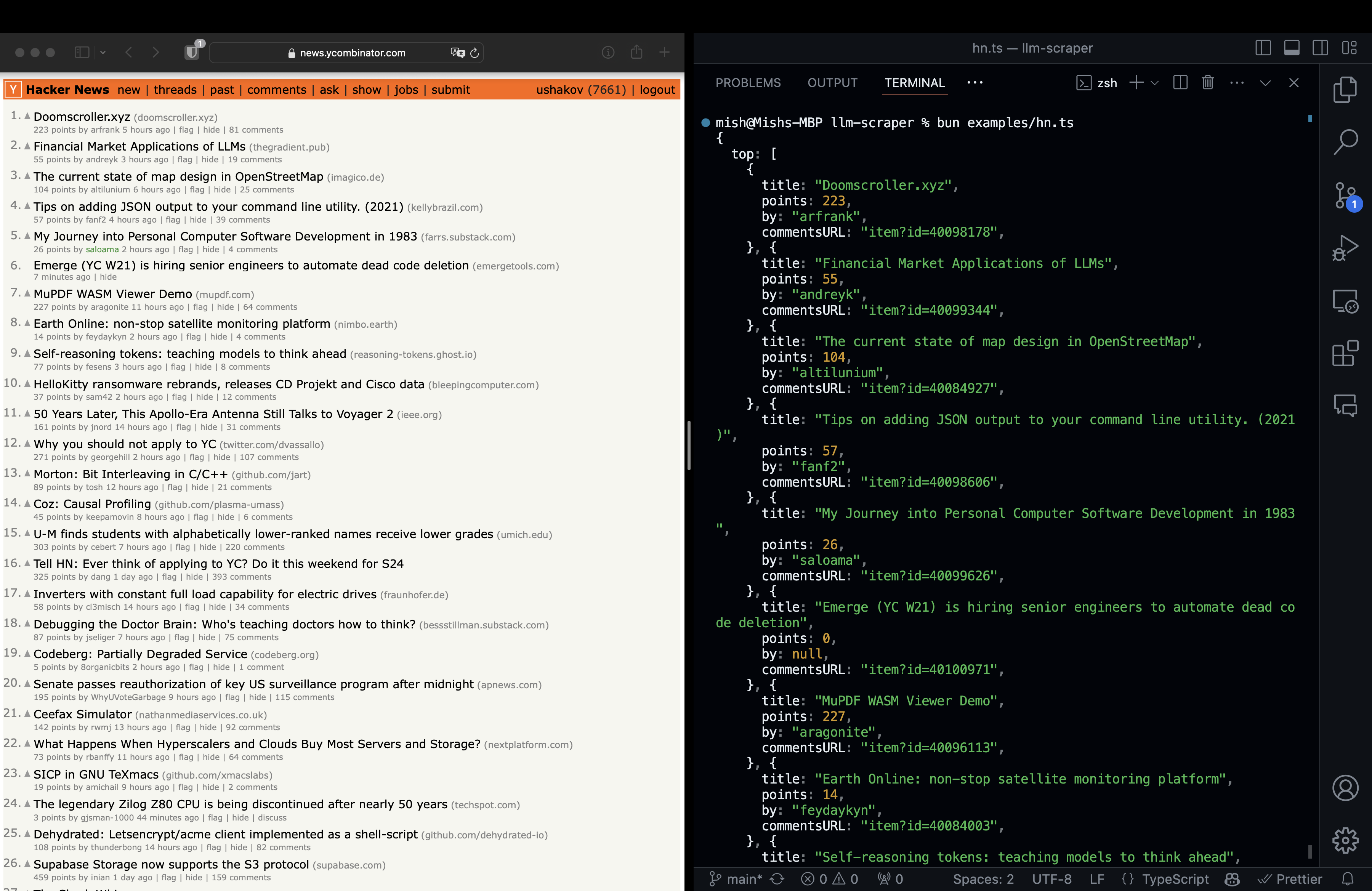
2. AsPoem: an open source Chinese poetry learning website
This is an open source project self-recommended by readers of this weekly (by @meetqy). It is a modern poetry learning website with rich poetry content and a good reading experience. About 3,000 poems. There are 1.7K stars on Github. Support website and mobile browsing.
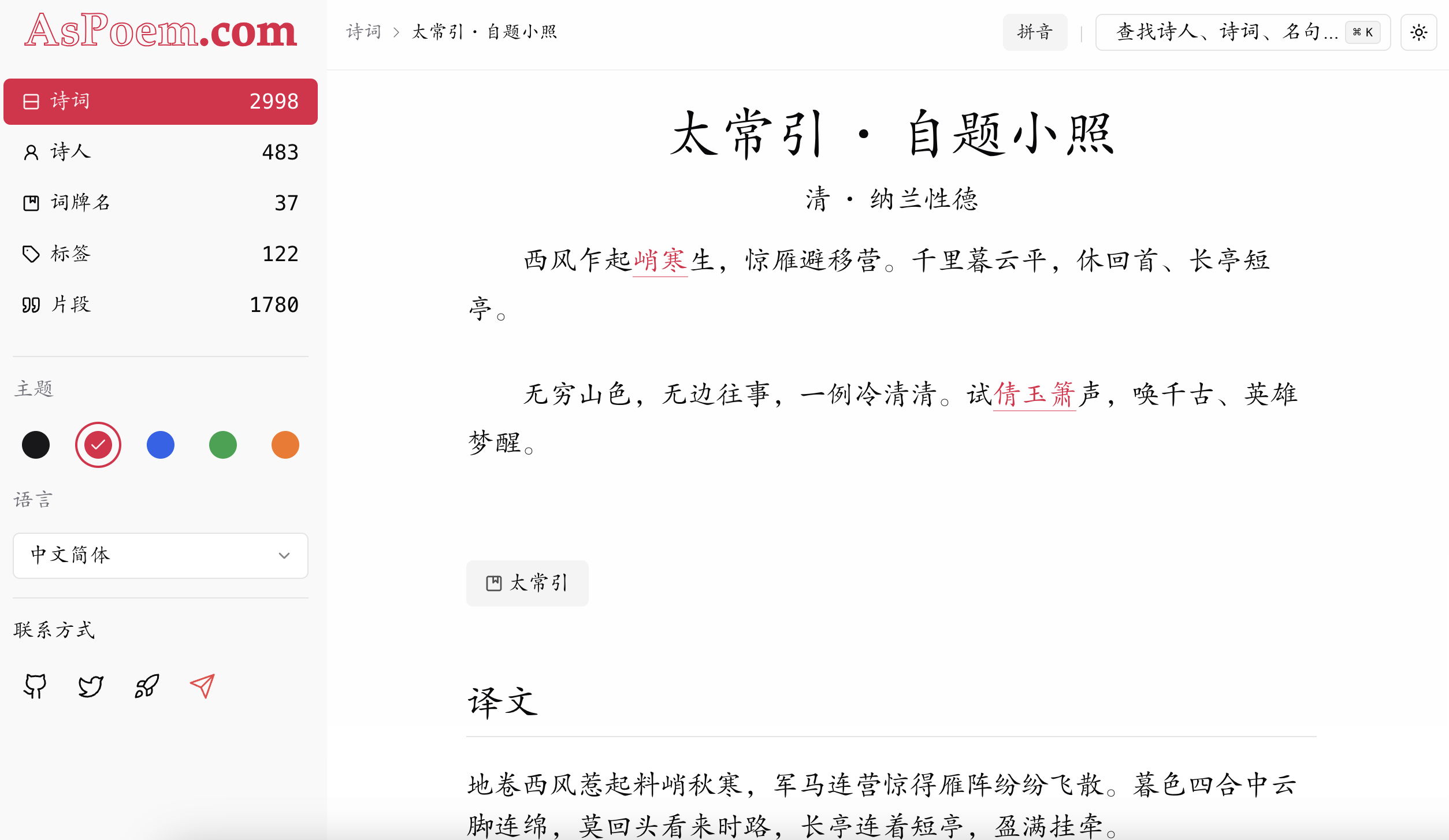
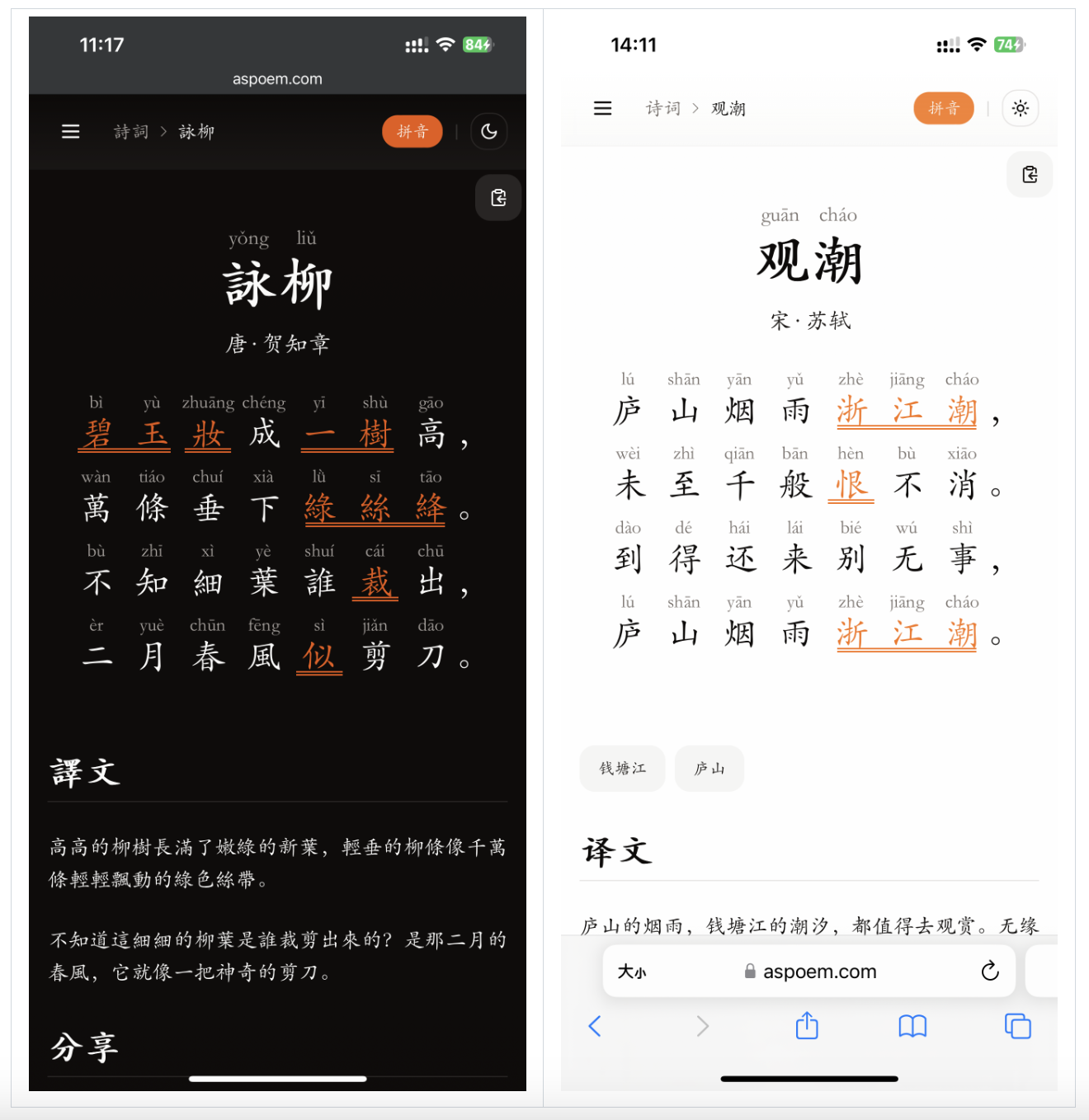
AsPoem open source project address
3. Growth strategy: How to get 60% of your customers from LinkedIn?
作者:Paul van Oijen
Not long ago, I shared my progress on growing my product design services agency from $0 to $4,000 and then $16,000 in monthly revenue. Since then, we have focused on a growth strategy that has been very effective, with 60% of our clients coming from LinkedIn, pure organic traffic.
The key to our success on LinkedIn is to keep posting content in various forms until we find something that hits the mark almost every time. And these posts, naturally attract our potential and future customers.
However, LinkedIn is different enough from other platforms that are more short-term, dopamine-stimulating, like X, TikTok, or YouTube.
1. Raise a dispute
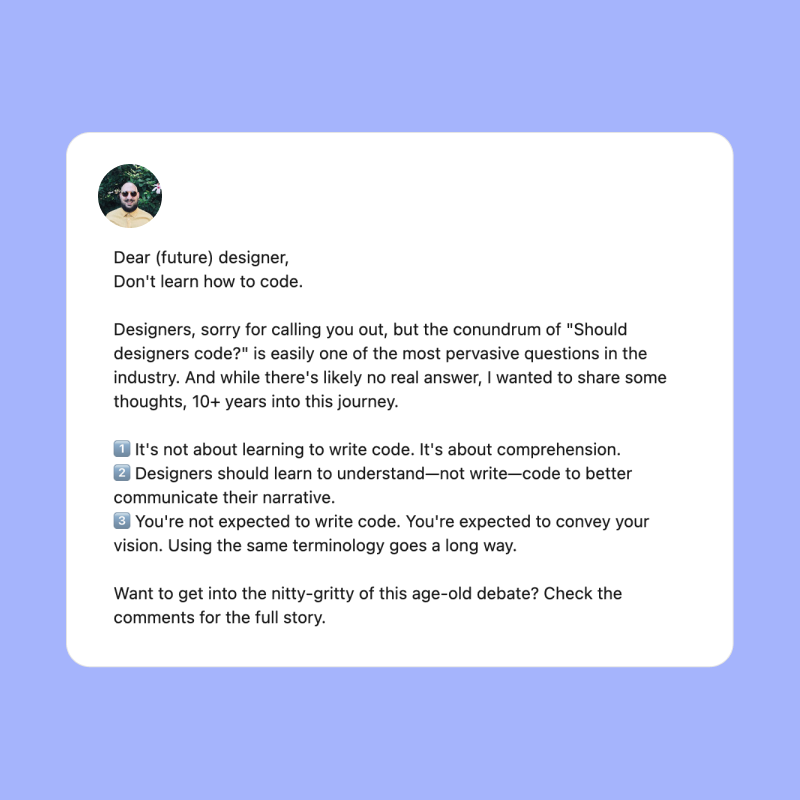
A LinkedIn post telling designers not to learn programming
Just like X, start the post with a controversial idea or opinion, guaranteed to grab attention. In this example, our audience and network consisted primarily of designers and engineers, and we told designers not to learn to code.It's clear to us that A) that first sentence is enough to make people stop scrolling and B) it's a concept that will prompt people to share their opinion
Here, as on other social media platforms, controversy is what works. So, if your industry has a status quo, behaviors that everyone exhibits, or that most competitors follow like a herd, then do the opposite. I promise, swimming against the current will bring you more engagement.
2. Emoticons, emoticons, emoticons
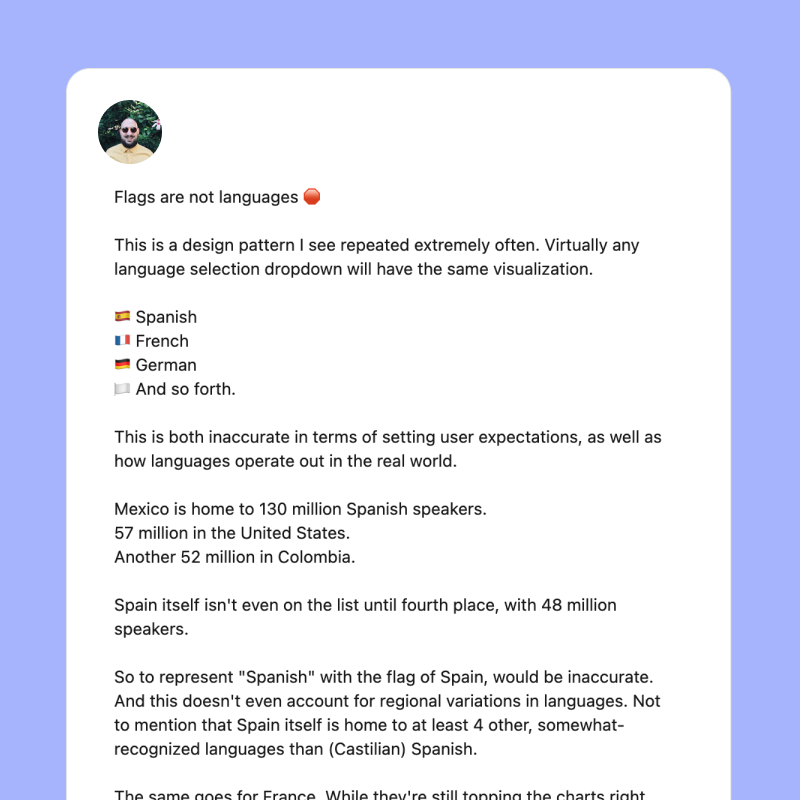
A LinkedIn post filled with emojis
There are three things LinkedIn likes.
1️⃣ Emoticons. 2️⃣ Nerdy, in-depth discussions from domain experts. 3️⃣ List
See what I did here? But really, LinkedIn users seem to eschew the traditional “look at me doing this” content favored by other platforms, preferring to delve deeper into a nerdy topic, whether it's within their area of expertise or not. For being an expert, or at least looking like one.
One thing that has always worked well for us is the emoji list. Whether they're numbered, like the one above, or use emojis to reinforce their point, they're simple and effective.
3. Image is king
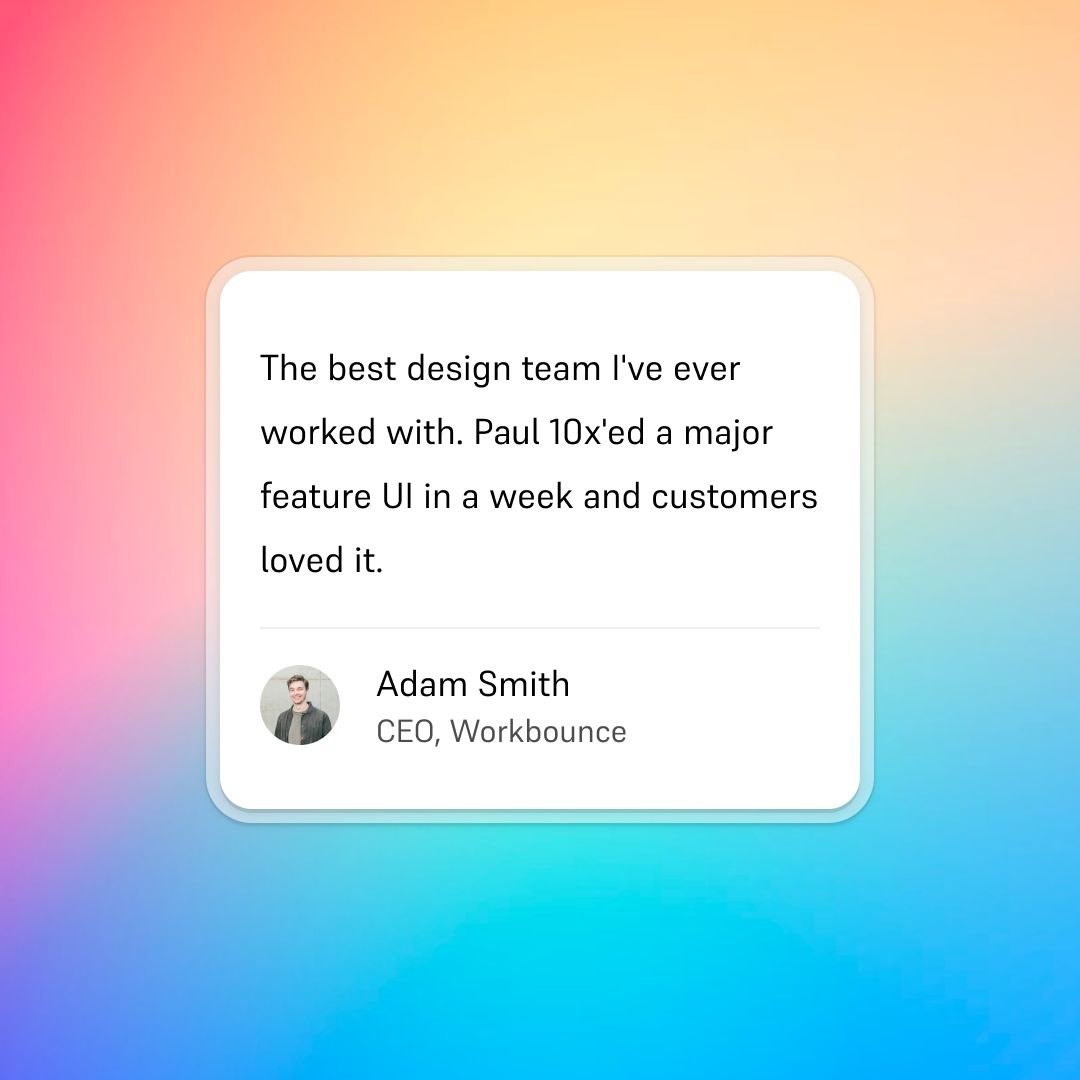
A LinkedIn post highlighting customer feedback on Incomparable Design.
While it may seem like a given to us, most user-generated content we see on LinkedIn doesn’t use images in any form.
However, on LinkedIn, images are king.
Posts that included images far outperformed those without, by as much as 50 to 60% more engagement. This is what makes people stop scrolling, grabs their attention, and invites them to read what you have to say.
So be bold. Use color. Try to stand out from LinkedIn.
Don’t just tell people you’re hiring, or you’re having a sale, or you just launched a new feature. Your post that is just a wall of text is not enough.
That’s it, these 3 key points are currently driving 60% of our user acquisition.
4. Made $60,000 in product built in three weeks

Hi everyone, my name is Sveta Bay and I am the co-founder of FounderPal. We create AI-driven marketing tools for individual entrepreneurs.
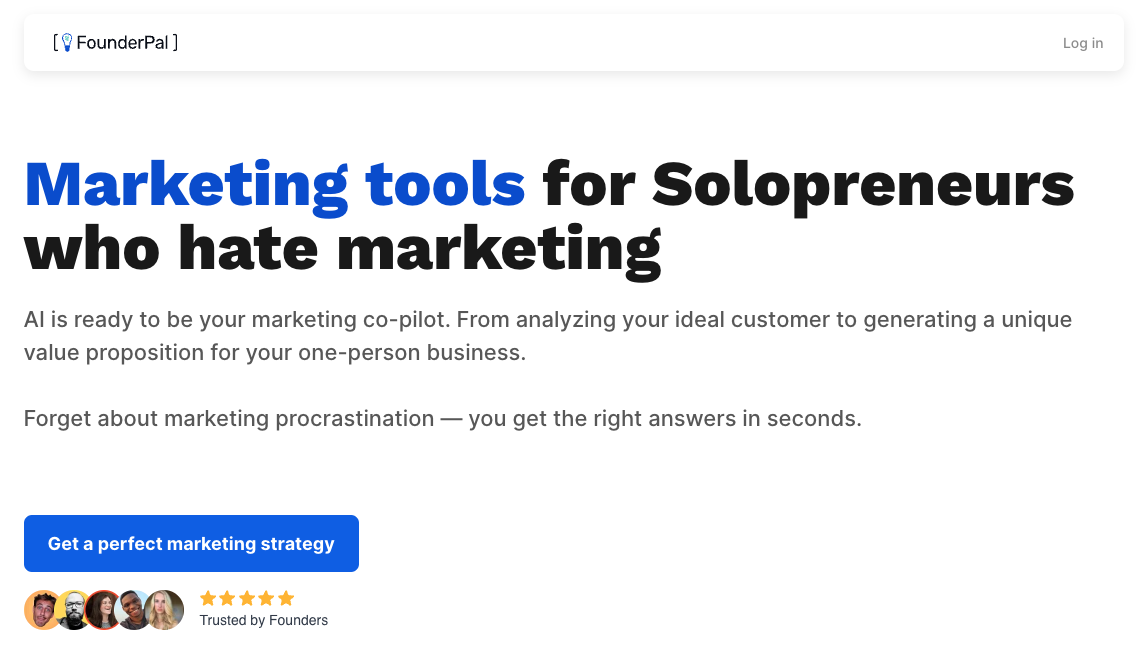
Entrepreneurs often have difficulty understanding target customers, defining market positioning, and generating marketing ideas. Our products are designed to solve these problems.
Our flagship product is the Marketing Strategy Builder. This is an interactive platform that helps users find unique marketing directions and then convert them into executable marketing tasks. It brings us about $10,000 a month in a one-time payment.
How did you come up with this idea?
Two years ago, we started our independent entrepreneurial journey and created MakerBox. After working together as a team for many years, we all wanted to spend less time communicating and more time building great products.
That’s why we started selling digital products around marketing. We have experience in this area, but most of the time we wing it, which brings us to $5,000 a month. But after a few months of experimentation, our revenue stagnated. We noticed that founders preferred tools over educational resources.
At this time, we added a little AI element. We have launched Marketing Mega Prompts, a paid collection of 40 unique ChatGPT prompts. Lo and behold, sales surged.
That’s when we realized – a lot of solopreneurs really wanted to outsource their marketing work. However, current AI products only focus on generating stupid email subject lines and spammy blog posts for the sake of SEO.
- Solopreneurs need a strategic CMO, not a content marketing intern.
- People prefer clicking buttons rather than talking to ChatGPT
- We know how to write unique mega-prompts
That’s how Marketing Strategy Builder was born.
Take us through the process of creating the first version of your product
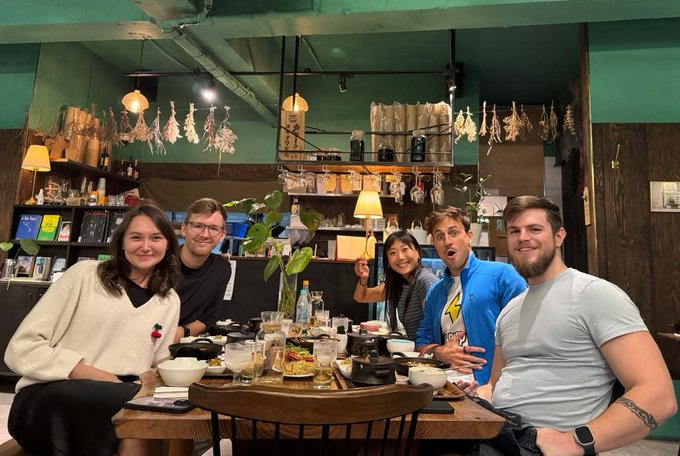
We built FounderPal quickly using no-code tools. Instead of spending 3 months learning basic programming, you could pay Bubble $32 a month to launch a product in 3 weeks. This approach allows us to work independently without any external funding.
The first version is very simple and costs only $150 for the first month (the cost of Bubble + OpenAI). It's better to launch a simple tool than be bogged down in an overly complex one.
This product process is enough to verify this idea:
- Describe your business in one paragraph
- Get 10 audience segments and choose the best one
- Get 10 value propositions and choose the best one
- Wait 5 minutes
- Get your persona, product positioning, 10 distribution ideas and 10 conversion ideas
Each strategy costs around $1 due to the expensive GPT-4 API and huge hints. But in a world filled with bad AI shells, it's worth it.
We decided to charge one-time payments to make it easier to gain early traction. Selling monthly subscriptions to AI products is difficult, and most users don't need a new marketing strategy every week. Simple and customer-oriented.
Describe the process of starting a business
We kept launch day simple. After all, it's just one day.
This is our three-step system.
- Schedule a post on Product Hunt
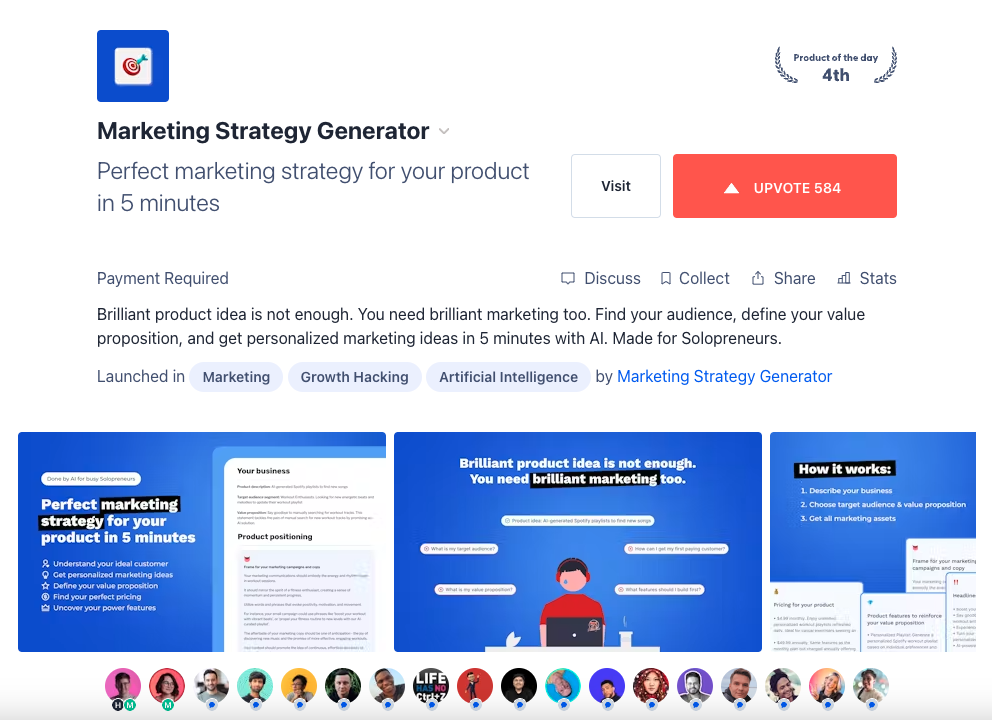
We like to post on Mondays because it’s not as competitive as Tuesday through Thursday and still gets pretty good traffic (compared to Friday through Sunday).
This is our post for the Marketing Strategy Builder. Some more helpful suggestions:
- Write a straightforward slogan. Removing all the “unleash” and “streamline” would be very helpful.
- Add 3-4 visuals to make your product more attractive. Limit your images to 3-5 colors to keep things aesthetically consistent.
- Write a short but story-telling first comment.
- Interact with every comment to drive activity under your posts
- Share your posts in relevant Slack and Facebook communities.But instead of asking for likes, encourage people to leave you honest feedback
Winning on Product Hunt ultimately depends on 3 factors:
- Is your product relevant to the average PH user?
- Do you have a large enough audience to gain early traction?
- Are there any big companies releasing on the same day?
Focus on getting into the top 5. This is enough to gain traffic and free promotion from the newsletter (for example, the AI newsletter monitors every AI-related tool).
- Write a simple and clear email
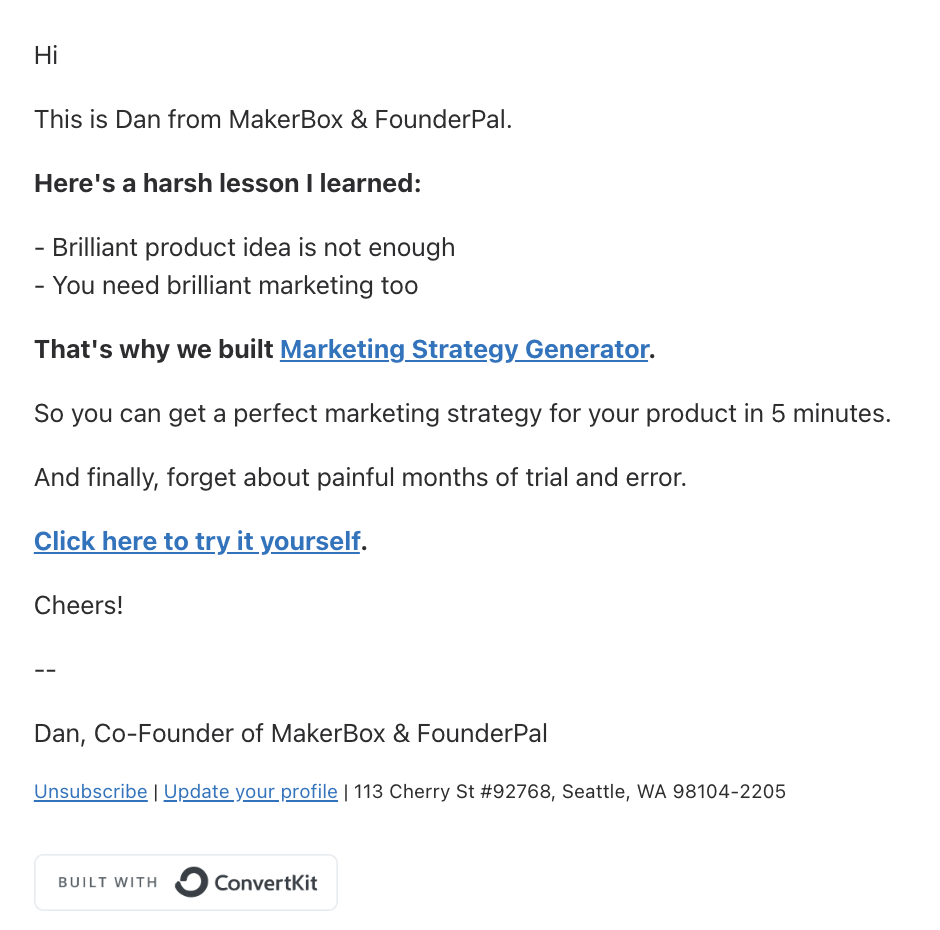
At that time, we had a mailing list of 13,000 people (now 25,000).
I don't like fancy emails. The more distractions, the fewer clicks on your CTA.
So every email I post looks like this.
- Tweet
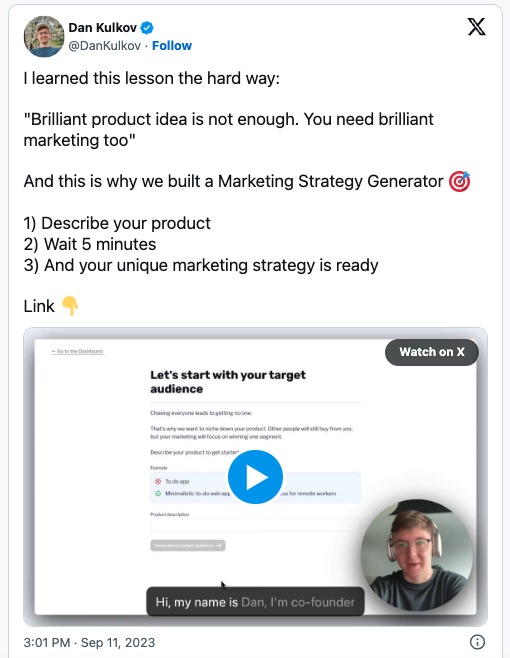
Now, posting founder videos on Twitter works really well.
They attract attention and cultivate relationships. Don't be shy, record yourself.
On launch day, we made $1249. Over the next two months, we added another $18,709. Continuous marketing channels, and then become a blockbuster.
Since launching, what steps have you taken to attract and retain customers?
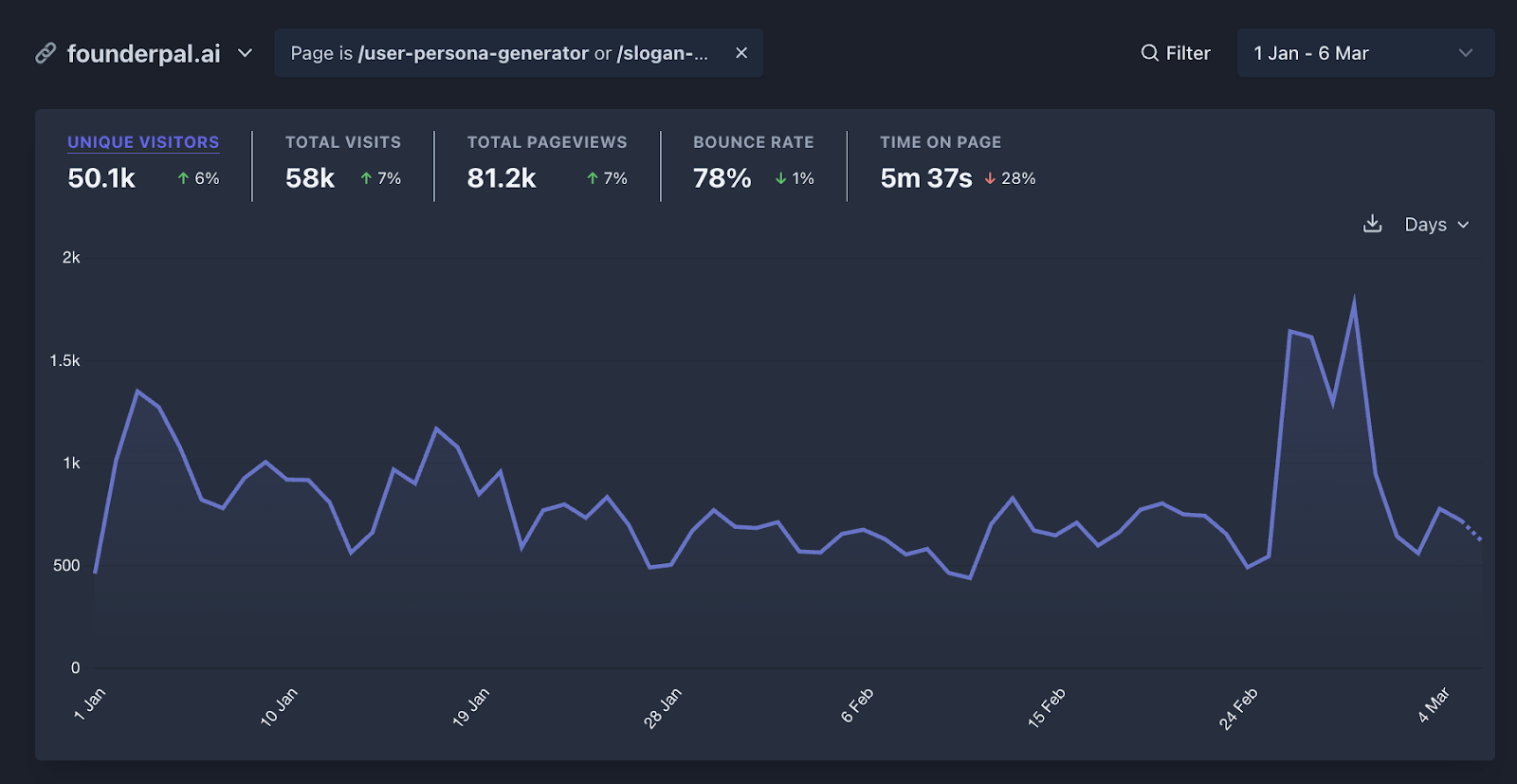
In short, we build simple AI tools that users can use for free. They get value and we get organic promotion of our paid products.
Here is our 10-step system for each tool:
- Find an overlooked keyword that is relevant to your product (e.g. user person generator)
- Build a simple AI shell in Bubble with two screens: input and results.
- Let users generate their first process (generate a persona) for free, without leaving an email.
- Offer an additional process (generate 9 marketing ideas for this “user person generator”) in exchange for emails.
- After the user completes the additional process, present your paid product. Since the connection is real, it's easy to promote.
- Subscribe these users to a simple automated email sequence. Offer more value for free and tell your product story.
- Launch this free tool on Product Hunt and Twitter to get as many people as possible to try it.
- Record a simple TikTok video about your free tool (with or without your face)
- Over the next week, you'll get dozens of free pitches from newsletters and TikTok influencers as they spotlight new free tools
- Over the next month, you will gain SEO results due to low competition keywords and backlinks
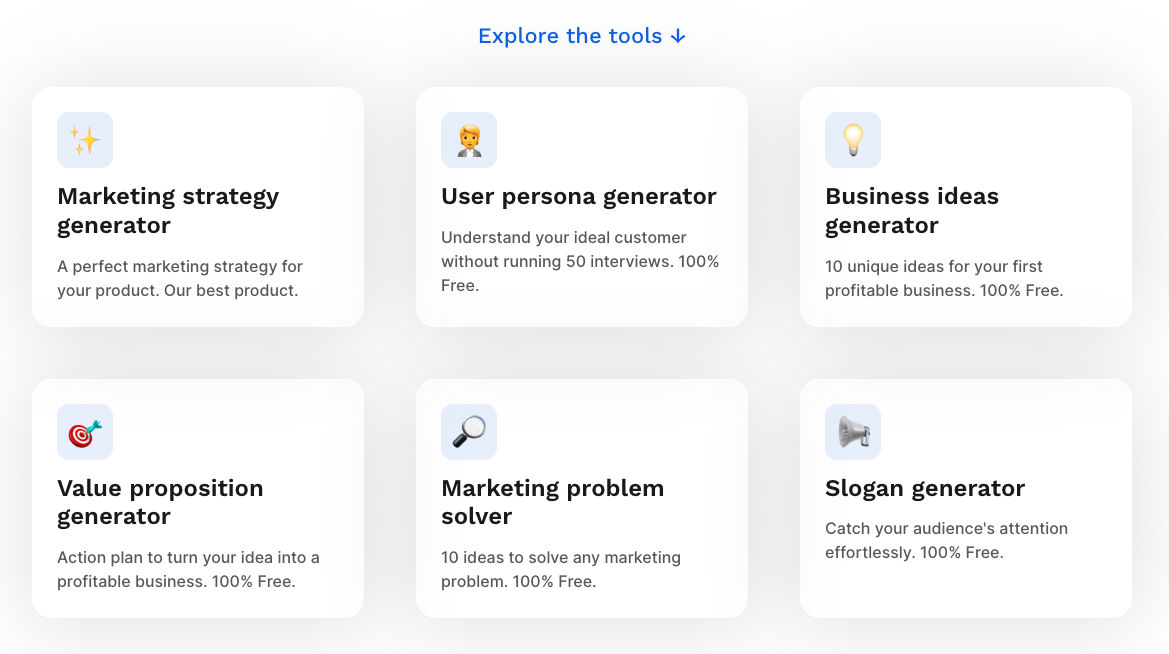
We built 5 free tools using the same approach: Persona Generator, Business Idea Generator, Value Proposition Generator, Slogan Generator, and Marketing Problem Solver.
They bring us 500-1000 unique visitors and 100 emails per day and cost less than $2.
Side project marketing is perfect for founders who hate intrusive and high-maintenance marketing.
For marketing, we double down on SEO and organic traffic to TikTok. Building generous free tools is far more effective than anything we've done before.
Marketing now has brought us 800 paying customers, a one-time payment of approximately $10,000 per month. By 2024, we hope to see 3,000 paying customers and $30,000 in monthly revenue while maintaining profit margins of over 80%. There is still a lot of work to be done!
Is there anything you learned that was particularly helpful or advantageous?
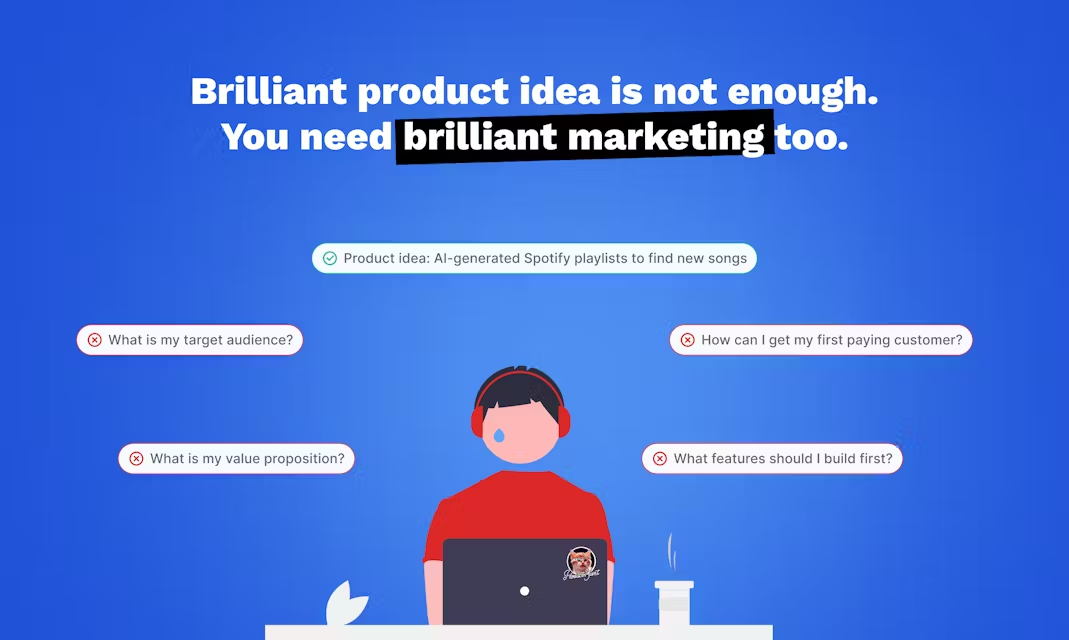
It’s not hard to start a business on your own, we make it harder.
FounderPal taught us a lot. But here are three of my favorite lessons:
- Do “boring” marketing. I always thought SEO and email marketing were for old-school businesses. But when done right, they trump all shiny marketing tactics. The average person still Googles and still reads email, it’s not too late to take advantage of them.
- Free attraction. If everyone keeps using their tools, make them available for free. If everyone is using gpt-3.5 to keep costs down, use gpt-4 in your product. Not being greedy is the simplest marketing technique in 2024.
- Take advantage of one-time payments. Of course, everyone wants recurring income to have a steady income. However, a good marketing channel will bring you steady income even with a one-time payment. And it’s much easier to sell a $199 one-time payment AI tool than a $39 per month AI tool.
Any advice for other entrepreneurs looking to start or just starting out?
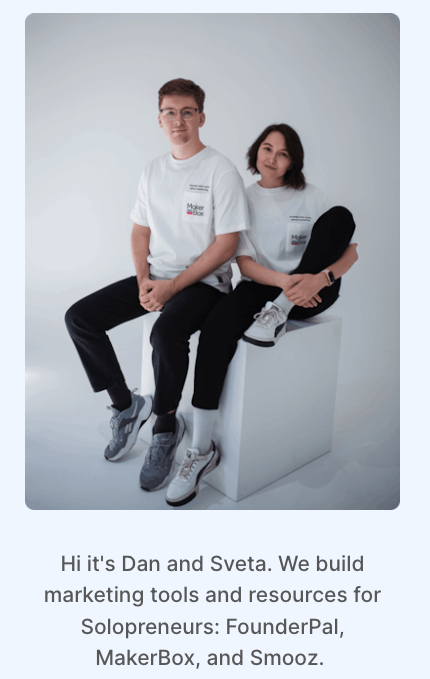
Here are 5 simple tips that have worked for us and others:
- Build for an audience. FounderPal’s first MVP failed. We learned our lesson and built a second product for the same audience. This brought us $60,000 in revenue in 6 months.
- Limit first release to 1 month. You don't need 10 features. You need a good product process that will validate that your business idea works. Keep it simple.
- Find ways to get traffic beyond launch day. In the first few years, you won’t become popular or see word-of-mouth spread. Find out what kind of distribution works for your product, otherwise it will slowly die within 1 month.
- Unless you can't, take advantage of the one-time payment. Too many AI products don't take off because founders try to sell monthly subscriptions.
- Spend 1 hour defining your product positioning. You can't launch a generic AI product and expect wildly different results. What makes your product unique? Why should people care? A good answer might save you six months of trial and error.
“It’s not hard to start a business on your own, we make it harder.”




GIPHY App Key not set. Please check settings